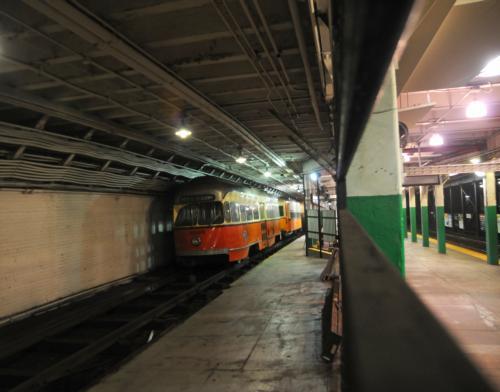Harvard was gearing up for another battle with the City of Cambridge. On one side, President Nathan M. Pusey ’28, pushing his Program for Harvard College—an $85 million campaign to up the number of undergraduate Houses from seven to 10—sought to acquire a stretch of prime river-front property owned by the Massachusetts Transit Authority. But from his corner of City Hall, Councillor Alfred “Big Al” E. Vellucci moved to block tax-exempt Harvard’s expansion, hoping instead that private investors would develop the land and augment the city’s coffers.
But before either party could have its way, the MTA (now called the Massachusetts Bay Transportation Authority) would have to agree to sell its 12 acres west of Kirkland and Eliot Houses near the Charles River. Called the Bennett Street Yards, the lot was the only facility for maintenance and repairs on the entire subway system. But it occupied some of the most valuable land in Massachussets.
Beginning in 1955, the University entered negotiations to buy the yards. In 1959, after four years of inconclusive talks, the University escalated its bid to acquire the Bennett Street Yards. But few then could have imagined what the yards would ultimately become.
GRABBING FOR LAND
For decades, land in Cambridge had been in high demand, so much so that even as Harvard and the MTA negotiated, a bill came before the Massachussetts state legislature proposing the construction of a 40-acre platform over the Charles River Basin near MIT, which would provide space for “apartments, research firms, or other industrial buildings”—and would expand the tax base for the City.
The land’s desirability meant that Cambridge real estate tended to carry a hefty price tag.
In 1959, Harvard offered to pay around $4 million, or the equivalent of $5 per square foot, plus an additional $1 million for the property. University officials said at the time that the extra million dollars—the equivalent of $7 million today—was intended to help the MTA relocate its switching yards, which was required in order for the transportation authority to sell its land.
There was some concern that the University would not actually be able to pay the amount it had promsed, according to Bruce L. Paisner ’64, who covered the ongoing negotiation over the Bennet Street Yards for The Crimson.
Taxed land in Cambridge also brings along a lot of revenue for the city. The possibility of losing even more land to the tax-exempt University didn’t sit well with some Cambridge and Massachussetts government officials.
The MTA did not pay taxes on the land, but there were some bidders who would.
In 1959, in addition to Harvard’s offer, a group of Philadelphia insurance companies told the Cambridge City Council that they, in conjunction with Cambridge realtor Rodney W. Long ’22, wanted to acquire the MTA land in order to construct a $50 million apartment complex on the yards.
BATTLING ‘BIG AL’
Vellucci was a major opponent of the University’s land buying plans and supported Long’s effort to acquire the MTA land.
“Big Al Velluci: he enjoyed pulling Harvard’s nose, and he was great at it,” said Frederick W. Byron ’59, who also reported on the Bennett Street Yard acquisition controversy for The Crimson.
Vellucci went on to serve three terms as mayor of Cambridge in the 1970s and 1980s. He made a name for himself by demanding that Harvard make a “payment in lieu of taxes.”
In February of 1959, the Cambridge City Council had considered, but ultimately voted down, an order proposed by Vellucci that would require the MTA to notify the body of any plans to sell land in Cambridge.
Commenting on the order in 1959, Councillor Pearl K. Wise said, “It seems to me that Harvard is not entitled to two more Houses facing the river.”
But other councillors, including Harvard graduates Edward A. Crane ’35 and Joseph A. DeGuglielmo ’29, defended the university’s efforts to acquire more land, citing the university’s “stabilizing effect” on the city’s economy due to its role as a major employer.
PROFILES IN CAMBRIDGE
The class of 1959 graduated without seeing a decision on the MTA yards. In 1959 the first of the Program for Harvard College Houses, Quincy, opened. Although the University continued its efforts to acquire the MTA land fo the next seven years, the reasons for buying the land changed dramatically.
“The turning point came in 1962,” Paisner, the reporter, said, “John F. Kennedy was the president. He came up to a football game [in Cambridge]...He saw the MTA yards and said ‘Aha! That would be nice spot for a library.’”
From that point on, according to Paisner, the University abandoned any lingering plans to build Houses on the Bennett Street Yards and redirected its efforts to helping bring Kennedy’s presidential library to the site. But they were ultimately unsuccessful; Kennedy’s library was built instead at Columbia Point in Boston.
In the fall of 1963, when the MTA finally found a new location for its carbarns in Dorchester’s Codman Square, Pusey announced that the University was no longer interested in building a House on the Bennett Street site.
And by 1964, the MTA announced that it was willing to sell the yards. In 1966 Harvard finally bought the land and made plans to relocate its Graduate School of Public Administration—renamed for President Kennedy—on the site.
—Staff writer Sarah J. Howland can be reached at showland@fas.harvard.edu.
Read more in News
Marathon Racers Run for Charity













